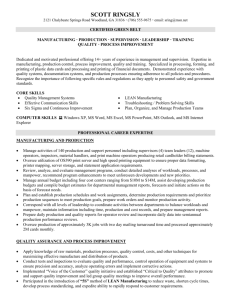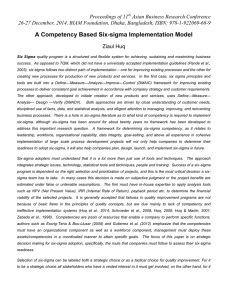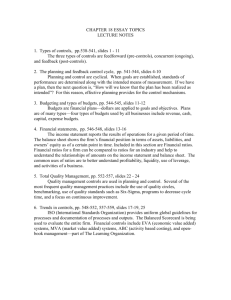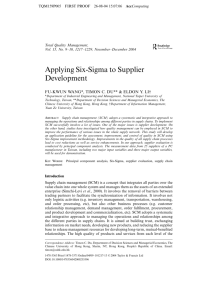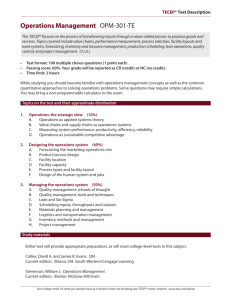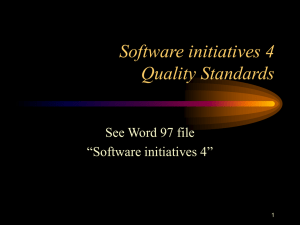An Introduction to Six Sigma
advertisement
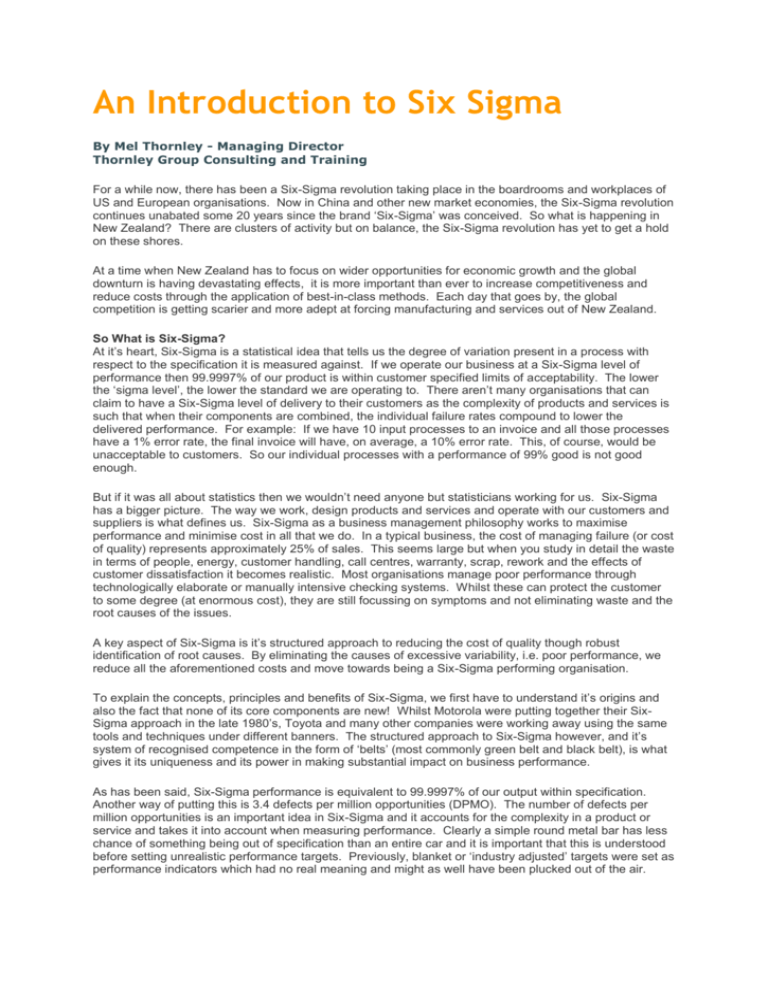
An Introduction to Six Sigma By Mel Thornley - Managing Director Thornley Group Consulting and Training For a while now, there has been a Six-Sigma revolution taking place in the boardrooms and workplaces of US and European organisations. Now in China and other new market economies, the Six-Sigma revolution continues unabated some 20 years since the brand ‘Six-Sigma’ was conceived. So what is happening in New Zealand? There are clusters of activity but on balance, the Six-Sigma revolution has yet to get a hold on these shores. At a time when New Zealand has to focus on wider opportunities for economic growth and the global downturn is having devastating effects, it is more important than ever to increase competitiveness and reduce costs through the application of best-in-class methods. Each day that goes by, the global competition is getting scarier and more adept at forcing manufacturing and services out of New Zealand. So What is Six-Sigma? At it’s heart, Six-Sigma is a statistical idea that tells us the degree of variation present in a process with respect to the specification it is measured against. If we operate our business at a Six-Sigma level of performance then 99.9997% of our product is within customer specified limits of acceptability. The lower the ‘sigma level’, the lower the standard we are operating to. There aren’t many organisations that can claim to have a Six-Sigma level of delivery to their customers as the complexity of products and services is such that when their components are combined, the individual failure rates compound to lower the delivered performance. For example: If we have 10 input processes to an invoice and all those processes have a 1% error rate, the final invoice will have, on average, a 10% error rate. This, of course, would be unacceptable to customers. So our individual processes with a performance of 99% good is not good enough. But if it was all about statistics then we wouldn’t need anyone but statisticians working for us. Six-Sigma has a bigger picture. The way we work, design products and services and operate with our customers and suppliers is what defines us. Six-Sigma as a business management philosophy works to maximise performance and minimise cost in all that we do. In a typical business, the cost of managing failure (or cost of quality) represents approximately 25% of sales. This seems large but when you study in detail the waste in terms of people, energy, customer handling, call centres, warranty, scrap, rework and the effects of customer dissatisfaction it becomes realistic. Most organisations manage poor performance through technologically elaborate or manually intensive checking systems. Whilst these can protect the customer to some degree (at enormous cost), they are still focussing on symptoms and not eliminating waste and the root causes of the issues. A key aspect of Six-Sigma is it’s structured approach to reducing the cost of quality though robust identification of root causes. By eliminating the causes of excessive variability, i.e. poor performance, we reduce all the aforementioned costs and move towards being a Six-Sigma performing organisation. To explain the concepts, principles and benefits of Six-Sigma, we first have to understand it’s origins and also the fact that none of its core components are new! Whilst Motorola were putting together their SixSigma approach in the late 1980’s, Toyota and many other companies were working away using the same tools and techniques under different banners. The structured approach to Six-Sigma however, and it’s system of recognised competence in the form of ‘belts’ (most commonly green belt and black belt), is what gives it its uniqueness and its power in making substantial impact on business performance. As has been said, Six-Sigma performance is equivalent to 99.9997% of our output within specification. Another way of putting this is 3.4 defects per million opportunities (DPMO). The number of defects per million opportunities is an important idea in Six-Sigma and it accounts for the complexity in a product or service and takes it into account when measuring performance. Clearly a simple round metal bar has less chance of something being out of specification than an entire car and it is important that this is understood before setting unrealistic performance targets. Previously, blanket or ‘industry adjusted’ targets were set as performance indicators which had no real meaning and might as well have been plucked out of the air. To achieve Six-Sigma performance in a process it is necessary to reduce variation. By doing this we are able to predict outputs, reduce waste and lower our operating costs. All with improved customer satisfaction. From my own experience of working in both manufacturing and service industries, from foundries to customer service, a mixture of improvement tools and techniques were in use prior to the advent of SixSigma. Being introduced to Taguchi’s approach to experimental design and the use of control charts was a revelation to me as a young engineer working in the Aerospace industry during the 1980’s. Along with numerous other tools and techniques their use was very powerful in the design and manufacture of products. With my move to the ‘black art’ of heavy steel castings in the early 1990’s I found that approaches to process improvement were centred around personal expertise and individual experience of past events. This is still the way many companies and organisations operate today. Whilst those things are valid in contributing to problem solving and improving processes, they need structure and robust analytical techniques to make them effective. Without this we find that we are going over the same ground, stabbing at causes (often at great expense) and not getting to long term solutions. Sound familiar? During a 10 year stint in the automotive industry from the mid 1990’s onwards I was exposed to the whole array of improvement methods that were taking that industry by storm at the time. Continuous improvement and TQM reigned but became superseded by Six-Sigma and Lean when large companies like Ford decided that all their suppliers should be Lean Six-Sigma focussed. The impact of this was felt wherever there was a significant automotive industry. The benefits are of course that we all drive cheaper more reliable cars with more of the features that we as customers want. Later, the service industries discovered Six-Sigma. The power of the customer focus that Six-Sigma gives and the huge cost savings through reduction of waste, ineffective transaction processes and customer dissatisfaction has made it very popular in the banking world. A high proportion of the institutions have a Six-Sigma programme to some degree or another. In 2000 I attended a Six-Sigma seminar on behalf of the company I was working for and the majority of attendees were from the financial services industry. Areas that are now taking notice of Six-Sigma are Healthcare and Government. Here, with budgets of millions of dollars, the opportunities are huge. From blood transfusions to correctional facilities, organisations are recognising the importance of effective processes and robust strategic project delivery. So if these techniques have been around so long and Six-Sigma contains nothing new, why narrow our focus on Six-Sigma? The answer is that there isn’t anything in the Six-Sigma toolbox that we should not be using. It is a comprehensive approach to resolving problems and delivering improvement projects. SixSigma can be disassembled and reduced to it’s components, but the power of the Six-Sigma approach is in it’s entirety. By using the established methods (some of which are quite complex) and following a specific management approach to using them, step change in performance or ‘breakthrough’ can be achieved. The established approach to continuous improvement, often described as the Deming PDSA cycle (Plan, Do Study Act), is very important and is incorporated in the Six-Sigma DMAIC (Define, Measure, Analyse, Improve, Control). The similarities are evident but the whole management of the improvement process follows a clear structure in Six-Sigma. The Six Sigma DMAIC Project Cycle Before describing the detail of each part of the DMAIC cycle, a brief outline of its objectives is needed. The reason for embarking on any improvement project is to deliver improvement! If we don’t have a structure to the way we manage it, we miss all the opportunities and issues that will either make or break the project. The DMAIC cycle ensures that steps are taken at each stage of the project to use facts and data in the decision making process. Use is made of simple decision tools and statistical techniques, which can be easily interpreted, through to advanced techniques that require us to use software and the input from trained people in order that we can use and interpret them. The DMAIC cycle creates a system of ‘gates’ that review the progress and robustness of projects against targets and the Six-Sigma project delivery process. In the end, if all the steps are followed then the opportunity for success is maximised. The Define Phase Before we do anything we have to understand, in detail, what we are working on. The ‘problem’ or ‘area for improvement’ has to be of significant value for an organisation in customer, financial or operational terms. The need for resources to be applied to Six-Sigma projects means that we have to concentrate on the bigger fish which are usually aligned to strategic objectives and have senior management authorisation. The definition of a significant project varies from one organisation to the next but it will always be something that has impact. In the ‘Define’ phase of a Six-Sigma project, we do literally as it says, we define and scope the boundaries of the problem and the resources needed to resolve it. It may seem to be a simple process but it is quite involved and rarely does the original problem statement remain the same from start to finish. A first step is to understand that everything is part of a process and all processes have inputs and outputs, supplier and customers. These can be internal suppliers and customers or external ones. The bigger the scope of the problem we are resolving, the more likely we are to have numerous inputs and outputs and extensive system complexity. Mapping out the process can be done in many ways. An advanced approach would be value stream mapping taken from Lean. A first approach in Six-Sigma however is to use SIPOC or the reverse logic of this, COPIS. SIPOC stands for Supplier : Input : Process : Output : Customer. The process part is that which contains the issue we are trying to resolve. By deconstructing things in this way we can start to understand the interactions within the process and at its boundaries. This method of analysis also allows us to further focus down on what our problem statement is. If we start too large in scope then the work, time and resources start to become too big for any benefit to be realised in a reasonable time scale. The Measure Phase Once our problem has been scoped and defined, we set out to gather data about the nature of the problem or process we are improving. This comes from a combination of sources and may include customer feedback, in-process dimensional measurement, % defective components or incorrectly filled in fields on a sales order form. Whatever the data source it must be robust and provide clear evidence as to the current state of the process under investigation. Six-Sigma uses numerous techniques to verify the usefulness of data and to establish if there are any further data requirements. The Analyse Phase Having collected data from the sources identified during the define phase and in the measure phase, it needs to be analysed for patterns, special causes and significance. There are a wide range of techniques used to do this ranging from pareto to control charting to hypothesis testing. Some simple and some not so simple. As throughout the Six-Sigma methodology, trained individuals are key to making sense of the process. It is at the analyse phase where we are most likely to jump in with opinions and solutions that will in most cases turn out to be short term or totally inappropriate. We sometimes see patterns in things that are essentially random. It is vital to stick to the improvement methodology and follow a robust process of analysis. The only conclusions that should be drawn should be expressible in the form of data. The whole point to the analyse phase it to ensure that we can generate theories on the root cause of our issue that are sound and based in fact. The Improve Phase Given that the data collected gives us a fact based theory of where the root cause of the issue lies, it is now time to consider changes that can be made to improve the process under scrutiny. There are a number of things to consider before we make changes, including the effect that they will have on other parts of the organisation, it’s suppliers and it’s customers. It is easy to lose sight of the system we operate in and focus entirely on the problem at hand. There are often cases where improving part of the system adversely affects the performance of the system as a whole. Depending upon the circumstances we might want to pilot a change, gather more data or run a series of experiments (Design of Experiments) to optimise a series of process inputs. Either way, the change has to be managed with people and process in mind. Keep in mind that this applies equally to product and transactional processes. Ongoing data collection and analysis is required to verify the changes are indeed permanent and not just temporary changes due to us putting scrutiny on the process. Once a process improvement has been identified and verified it is now ready for implementation. The timing of this milestone is critical for the project as revenues are only possible once the change is put in place. The Control Phase Having successfully proven our change is beneficial and we are reaping the rewards that we set out to achieve, it is essential that the gains are maintained and that any learning obtained is transferred across the organisation where possible. The means of control will be, to some extent, unique to each case but will follow a framework that involves ongoing measurement of the critical to quality parameters, ensuring that standard operating procedures are in place and that all people associated with the new process are trained and competent. This also stretches to them being competent in the routine analysis of process information as might be found on a control chart for example. Basic skills in process improvement will also be necessary, particularly line management and supervision. Summary This has been a brief attempt to explain Six-Sigma. There are many sources of reference available on the subject, both in print and on the web for those with a taste for more knowledge. It is a complex subject that requires a detailed understanding of the methods employed and requires competent individuals to manage it. However, only a few people are required to have a high degree of competency in an organisation. The majority of the knowledge required can be gained reasonably quickly. A commitment by senior management is the most significant requirement when implementing any change and once this is obtained, the process of applying the Six-Sigma business model is one of planning, training and doing.
